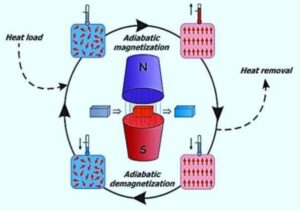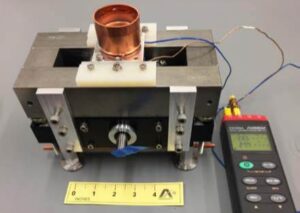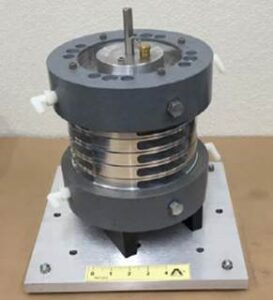Magnetocaloric Engine
for Refrigeration and Heat Conversion
Revolutionary high-payoff technologies for improving energy efficiency in aerospace and commercial processes including refrigeration, component actuation, and automotive.
Aqwest is developing a revolutionary magnetocaloric refrigerator (MCR) for advanced refrigeration and air conditioning (AC) in buildings, industry, and transportation offering over 2-fold improvement in efficiency over traditional vapor compression cycle (VCC) technologies. The Aqwest MCR overcomes the limitations of prior attempts at MCR by exposing a magneto-caloric material to a proprietary distribution of magnetic field varying in time and space in concert with an innovative thermal path switching to produce a “bucket brigade” heat pumping effect.
The Aqwest MCR is simple and self-contained as it uses no pumps, heat exchangers, plumbing, or regenerators. The MCR is a green technology producing net-zero green house gases (GHG) emissions.
We are also working on operating the magneto-caloric effect in reverse to convert heat directly into mechanical energy with a conversion efficiency 2-times higher than existing Rankine cycle technologies. The Aqwest MC engine (MCE) is leveraging latest magnetocaloric material and permanent magnet technologies to realize the century old dream of efficient direct heat conversion. Applications include utilization of low-level heat or waste heat recovery for production of electricity and propulsion.
The development of magneto-caloric heat technologies at Aqwest was supported in-part by contracts from the Missile Defense Agency and the U.S. Department of Energy.
Aqwest has 3 US patents issued and 1 pending application for magnetocaloric technologies



References
- Einstein, Annalen der Physik 17, 549, 1906 and 19, 371, 1911
- Edison, US patent 476,983, June 14, 1892.
- Tesla, Pyromagneto-electric generator, US patent 428,057, May 18, 1890
- Vuarnoz, et al., “Thermodynamic and energy efficiencies of magnetocaloric energy conversion utilizing industrial waste heat,” Int. J. Exergy, Vol. 10, No. 4, 2012
- P.W. Egolf, et al., “Magnetic power conversion with machines containing full or porous wheel heat exchangers,” JMMM, Vol. 321, pp.758–762, 2009
- Palmy, et al., (2007) “Levitation and acceleration of a thermo-magnetic wheel,” Proceedings of the Second International Conference on Magnetic Refrigeration of the International Institute of Refrigeration, IIF/IIR, Paris, pp.299–307, 2007
- W. Egolf, “The potential of heat flux conversion to electrical power by the magnetic Curie wheel method,” Univ. of Appl. Sci. of W. Switzerland (HES-SO), Swissnex, San Francisco, CA, July 2008
- Bruck, “Magnetocaloric materials for Room-Temperature Refrigeration,” in Fundamental Aspects of Materials and Energy, Technical University of Delft, Holland, 2010
- Bingfeng Yu, “A review of magnetic refrigerator and heat pump prototypes built before the year 2010, IJR 33 (2010) 1029-1060
- Kitanovski and P. W. Egolf, “Thermodynamics of magnetic refrigeration,” IJR 29, 2006, 3–21
Copyright © Aqwest, LLC all rights reserved.
